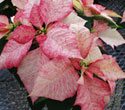Poinsettia Plant Growth Regulators
There are several options for growth regulators on poinsettias and the chemicals and rates utilized vary considerably due to climate and grower preferences. In the warmer temperatures of the deep south, we generally use chemical than would be used in cooler regions. In these examples we will use a combination of sprays, early drenches and a late drench to achieve desired heights. Our objectives are to achieve height control with the least possible effect on bract size.
Guidelines for Sprays
Prior to Oct. 1 we will use a tank mix of B-Nine and Cycocel.
- High rates are 2,500 ppm B-Nine and 1,250 Cycocel.
- Standard rates are 1,500 ppm B-Nine and 1,250 Cycocel.
- Low rates are 1,000 ppm B-Nine and 1,000 Cycocel.
This tank mix provides considerably greater activity in warm climates. In cooler climates, many growers use only Cycocel. B-Nine generally is not used after initiation date on poinsettias in any climate. For Florida, we use Oct. 1 as the natural day initiation date. In our examples, we may vary from these guidelines slightly depending on how vigorous the plants are and the weather.
Guidelines for Early Drench
The objective of early drenches is to achieve good size control with less effect on bract development compared to PGR sprays. The early drench is sometimes referred to as a low-dose or micro-drench because the rate used is much lower than late drench rates.
Early drench Bonzi rates
- 1/10 - 1/7 ppm for medium vigor varieties such as Freedom, Prestige and Orion
- 1/10 – 1/5 ppm for more vigorous varieties such as Monet Twilight and Snowcap
- At this time, we do not have enough experience to recommend rates for very low vigor varieties like Chianti and Pepride.
An early drench is applied as needed using the same decision process as used for making spray applications. The low rate does not stop elongation and only slows plant growth similar to the effect of a spray. We initially plan to use 2-4 early drenches on a crop similar to the way we would use sprays. Unlike sprays, there are no cutoff dates for the early drench and we will use it as needed up to when the late drench is an option. Growers in cool climates have been successful the past 2-3 years using rates of 1/10 to 1/8 ppm for most varieties.
The advantages of the early drench are that there is not a cut off date and that they provide good control with less effect on bract development compared to sprays. This is particularly true in October when sprays can cause problems with the small expanding bracts. For growers, the early drench can either replace some or all of the sprays. While, early drench applications are generally safer than sprays at the same time, problems can occur if too much is applied just like all PGR usage. Any of the media active growth regulators can be used for drench applications, but rates will vary depending on activity of the chemical. We will use Bonzi in these examples.
Guidelines for Late Drench
The objective of this procedure is to stop elongation and hold the crop at the desired size.The later the drench is applied the less it affects bract size. The rates used for the late drench are too high for earlier applications.
Warm Climates
- The plants should be within 1 inch of final size
- There should be one bract in full color.
Bonzi late drench rate is 1 ppm for medium vigor varieties like Freedom Red, Prestige and Orion.
Cool Climates
- The plants should be within ½ inch of final desired size
- There should be at least two bracts in full color.
Bonzi rate for medium vigor varieties is 0.5 ppm.

